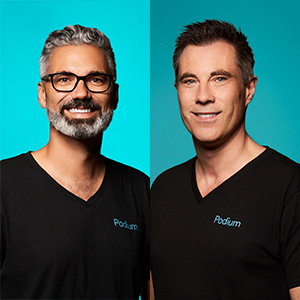CIO50 2021 #26-50 Harvey Worton and David Lipscomb, Lendlease

The property sector has been one of the last to industries to harness digital transformation. Data sits in disconnected silos, which means it can’t be used to provide insights into how to drive improvements to sustainability, health and safety and more.
Lendlease co-chief information officers in Australia, Harvey Worton and Dave Lipscomb and their teams have worked to change that and make property and construction more digitised and connected. They have led the rollout of several innovations across Lendlease in Australia.
In June 2020, they launched property lifecycle platform, Lendlease Podium; a set of digital products that connect the supply chain across the sector through real-time live data sharing. The platform also enables Lendlease to build digital twins, or digital versions, of buildings before they are constructed.
The company is using the platform across several of its key projects in Australia, Singapore, the United States, and Milan.
Early outcomes the organisation is seeing include:
- Reduced risk in projects through early identification of design issues before the shovel hits the ground
- A 20% reduction in costs due to more reliable data sets
- A 60% reduction in the time it takes to complete projects through the automation of design and engineering plans.
In early 2021, the company moved away from an outsourced model for customer support. It introduced Google Cloud Contact Centre AI to create a ‘one stop shop’ for its IT, people and culture, and finance helpdesks.
“We were up and running globally within seven weeks,” says Lipscomb. “Our employees now have the choice in how they engage with us. They can choose from self-service online delivery of answers, or they can choose to speak to us in person from local members of the team who can resolve issues in most cases on the first call.”
In a manual business, projects are often managed based on skills, experience and personal preference. For Lendlease to continue to improve its safety and sustainability outcomes, the team was asked to create a solution that would automate project governance and decisioning. That solution is a product called Oli, which offers better insights into each project’s risk and portfolio management.
Meanwhile, the ‘build to rent’ market (the construction and operation of buildings created with the purposes of renting spaces out to tenants), is a new and growing business for Lendlease in the United Kingdom.
“The customer lifecycle is different to the engagements,” says Worton. “We needed to learn more about tenants attracted to ‘build-to-rent’ so we could attract, engage and lead relationships with our rental tenants.”
To do this, the team customised a solution that delivered real-time integration of customer product and operational data. This enabled the creation of a new market and engagement program for the Lendlease business.
Team work
The pandemic has changed the way people want to experience the property search process. Worton and Lipscomb were asked to come up with a way to deliver totally virtual buying journeys. Along with their teams, they created a virtual platform that enables potential tenants to view, walk through and inspect apartments safely, and the detail needed to make a decision.
“The added benefit to this was that we were also able to reduce our reliance on third-party agents,” Worton says.
The co-CIOs were appointed in June last year at a time when COVID was impacting the world and Lendlease’s office-based staff were sent home to work. Within 24 hours, the largely relationship-based organisation moved to virtual meetings.
“We now run more than 100,000 virtual meetings a month and have maintained a healthy engagement and interest in digital tools available to solve problems,” says Worton.
Lipscomb says that throughout his career, he held the view that he needed to have all the answers and not make a mistake.
“Yet over the years, the key lesson I have learnt is that leadership is about creating teams that can solve problems together. I can be wrong, and I have the confidence to say I do not know the answer,” says Lipscomb.
“In creating a culture of transparency and of both success and failure, we are building greater trust as a team and with our stakeholders. All news is good news when it is delivered and received without judgement,” he says.
Meanwhile, looking back on his career, Worton says he initially held the belief that his success was dependent on the modelling of how others performed in the role.
“In the duration of my career to date, I had experienced a moment in time where I did not connect with a senior stakeholder. They were successful and well regarded, and I spent my time trying to emulate what I thought they wanted me to be. In doing so, I lost focus on who I was as a person and what I brought to the table,” he says.
Worton says he now coaches his team to take the time to learn from others, but “it is ultimately about following your own path, succeeding and failing along the way and learning from those experiences".
“To my graduate hires, I encourage them to all be confident, accept that not everything will go to plan and to celebrate both successes and learnings from failures. They will all help us grow and continue to bring our best to the workplace every day.”
Byron Connolly